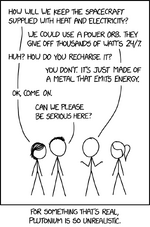steve_bank
Diabetic retinopathy and poor eyesight. Typos ...
General issues for space travel.
Energy
Unless you get around Newton's law, Force = m*a and Energy = Force * Distance. Fuel to get back from Mars in a large vehicle with life support may be a problem, let alone leaving the solar system.
Life Support
Does entropy apply? Can O2 and H2O be recycled without loss in a closed system?
Structure
There were pictures of a shuttle window hit by a micrometeorite in orbit. It left a con depression in the window but did not penetrate all the way.
High speed turns and deceleration are a problem. Reaction forces on the structure.
If the structure is rotating it has to be balanced around the spin axis to avoid wobble, and it compounds making maneuvers.
Heat
Unless you get around thermodynamics waste heat is a problem. If the shuttle could not open the bay doors and expose the radiators it could not stay up even with its small electrical load. You can look at the specs for the ISS cooling system,
Equipment
Breaking a system down into redundant modes is routine. There are chips designed to allow 'hot swapping' modules while the system is on. Mechanics can also be made redundant.
But when something breaks you still have to repair or replace it. Medical equipment.
The shuttle had three redundant computers. Each was designed and coded by independent teams.
No matter how much analysis, testing, and simulation is done there is always the 'X factor', the unknown. As in Apollo 13.
Propulsion
Unless the other issues are resolved propulsion is a moot point.
Energy
Unless you get around Newton's law, Force = m*a and Energy = Force * Distance. Fuel to get back from Mars in a large vehicle with life support may be a problem, let alone leaving the solar system.
Life Support
Does entropy apply? Can O2 and H2O be recycled without loss in a closed system?
Structure
There were pictures of a shuttle window hit by a micrometeorite in orbit. It left a con depression in the window but did not penetrate all the way.
High speed turns and deceleration are a problem. Reaction forces on the structure.
If the structure is rotating it has to be balanced around the spin axis to avoid wobble, and it compounds making maneuvers.
Heat
Unless you get around thermodynamics waste heat is a problem. If the shuttle could not open the bay doors and expose the radiators it could not stay up even with its small electrical load. You can look at the specs for the ISS cooling system,
Equipment
Breaking a system down into redundant modes is routine. There are chips designed to allow 'hot swapping' modules while the system is on. Mechanics can also be made redundant.
But when something breaks you still have to repair or replace it. Medical equipment.
The shuttle had three redundant computers. Each was designed and coded by independent teams.
No matter how much analysis, testing, and simulation is done there is always the 'X factor', the unknown. As in Apollo 13.
Propulsion
Unless the other issues are resolved propulsion is a moot point.


